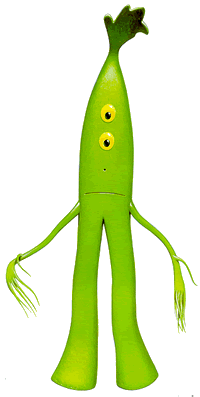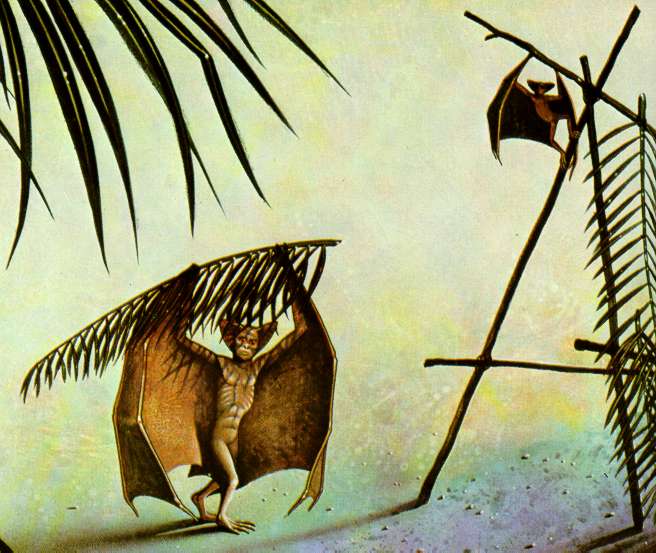| Home | class
topics grading rules |
resources links reading |
contacts feedback office hours |
|
||
intelligence and: |

|

|

|
 |
 |
 |

Evolution of Intelligence I
Limiting factors:
energy sources
problems needing
solution
mobility
questions & assignment
Energy sources
In the section on Metabolism, I noted that only aerobic metabolism provides enough energy for multicellularity, and hence intelligence, to arise. However, there are many different levels of energy available to the whole multicellular, aerobic organism depending on what it eats, or, more precisely, on its energy source.
 |
| Totally Bogus (:->) (from Barlowe's Guide to Extraterrestrials) |
Photosynthesis: A widespread form of energy is the radiation of the local star. In some ways this seems like such an easy, obvious way to solve the problem of finding food, one wonders why any organism does it any other way. The answer is that the amount of energy which can be obtained is actually very small. Plants do not move around under their own power because the energy needed is orders of magnitude beyond anything available to them. (Yes, I know about Euglena. Maybe I should limit that statement to multicellular plants.) Because the energy per unit of collecting surface is small, the collecting surface (for instance leaves) has to be extensive. That further limits any possibility of mobility. In short, the Little Green Men so well known from the literature are Totally Bogus.
Photosynthesis is just one type of the more general condition in which organisms acquire their energy from inorganic sources. This is called autotrophy. There are also chemautotrophs: creatures that use the chemical energy in non-carbon compounds, such as some of the ones clustered around deep sea volcanic vents. Several different compounds are used, for instance hydrogen sulfide. Whether photosynthetic or chemical, however, all autotrophs have very low energy yields.
Heterotrophs: The other way of obtaining
energy is to eat other organisms, whether plants or animals, and use
the chemical energy in their carbon compounds. Or, to phrase it more
precisely, to ingest carbon sources produced by other living organisms.
Here again, there are different levels of energy available.
A substance like grass has comparatively low levels of digestible,
energy-producing, compounds for its volume, and it is hard to digest,
hence it takes a great deal of energy to process. The payoff, therefore,
is relatively low. Against that, grass is enormously abundant. If
the organism is willing to spend most of its time eating, the problem
of finding food will be small.
A special case of organisms that eat other organisms are those that
eat dead things. Fungi are the best known example. Many saprobes are
bacteria. Saprobes live on the decaying matter they eat, so food is
as plentiful for them as for autotrophs. (Vultures, hyenas, and the
like, do not belong with this group since what they are really doing
is eating animals which are so recently dead that their cells are
still mostly alive. These animals are not actually processing decayed
cells.)
High-energy food, on the other hand, like fruits, seeds, or other animals,
is much less plentiful. When the food is other animals, there is the added
problem of getting them to cooperate in becoming dinner.
Solving problems
This brings us to the central issue in the evolution of intelligence. Intelligence will only evolve if its presence solves a problem for the organism. Intelligence has to evolve, because evolution is how new traits appear and intelligence is definitely a new trait that evolved well after the basic original bacterium.
Evolution operates by natural selection: traits that help an organism survive to reproductive age, and that help it to produce offspring that do the same, will be in evidence in those succeeding generations. Traits that did not do this will disappear with the organisms that died before they could pass them on.
The solutions available to an organism depend on evolutionary constraints. A clam, for instance, does not have the option of developing a large brain and intelligence to solve its problems because it does not have the necessary basic neurological organization to go down that route. There are no brainy clams for natural selection to favor. The whole mode of life of a clam, such as being sessile and feeding on an abundant, ubiquitous food source (see below), works against developing intelligence. Good solutions to problems for a clam are things like better camouflage or burrowing ability, rather than intelligence. Another example is the concept of intelligent insects. The size of insects on Earth is constrained by the weight of their exoskeletons. The constraint of small size also limits their head size and hence brain size. Higher cognitive functions take a large number of neurons and insects have orders of magnitude too few. An organism has to have the neural equipment to develop a big enough brain. Otherwise intelligence is not an option even if it would be helpful.
The first problem an organism faces is finding food. If finding
food is not a problem, for instance for plants, intelligence has
no problem to solve. In that case, having something equivalent to
a brain is pure cost without any payoff. The plant has to use up
precious energy to make the cells and send messages along its "nerves,"
all without deriving any particular increase in its ability to live
long or prosper. As a matter of fact, the energy it wastes on its
equivalent of a brain will reduce the energy available to
grow new leaves or make more seeds, so the "smart" plant
will be at an actual disadvantage relative to other plants. The more
"difficult" a food source
an organism has, the more intelligence may be useful for obtaining
it.
The next problem is avoiding predators. This is a problem even plants have, but given their other "lifestyle choices," so to speak, intelligence is not an option for them to solve it. Intelligence is useful for recognizing predators and suggesting the best escape. If there is no escape, as in a plant rooted to the ground, or a clam or coral, there is no point being intelligent about predators. And plants, as we already saw, have to be rooted to the ground (or floating in the water) because they have too little energy to do anything else. Only in mobile organisms can intelligence assist in the process of avoiding predators.
 |
| Parental care on Earth by a Surinam toad. From Bylinsky, 1981. Illus.: Wayne McLoughlin. |
Another problem is reproduction. How much of a problem it is depends on how the species in question does it. Many plants solve the problem by broadcasting pollen and hoping for the best. Some fish find members of the opposite sex and then broadcast sperm and eggs, reducing the element of chance. Some animals are very particular about mate choice and then devote a great deal of parental care to the offspring. Humans do this, as well as many birds, some frogs, fish and so on. Intelligence can help solve the difficulties involved, but the amount needed is not high.
The biggest problem faced by any organism, at least judging by the degrees of intelligence evolved to deal with it, is interacting with other members of one's own species. Survival and reproduction are incredibly simple compared to arguing with the neighbors. All of the most intelligent creatures are social, including cetaceans, primates, and canids. The one exception are octopods, which are more or less solitary. However, their level of intelligence has not been studied to the same detail as the others.
What this means for where intelligence probably will not be found: Since intelligence evolves only to fill a need, it is not likely to occur in autotrophs and it is likely to be minimal in creatures with plentiful food sources. It is also difficult to see how it could arise in space. Free-floating gas clouds or what-have-you do not have any problems intelligence could solve. They might be escaped artificial intelligences, vast molecular computers that grew bored with space traffic control for instance, but that is a different matter from naturally evolving in space.
Mobility
Mobility creates many of the problems which intelligence can then be used to resolve. A mobile animal can figure out where to go and a way to get there. It can try to flee predators and figure out the best way to do that. It can hunt other animals, in which case it can figure out the best approach. Or it can use other limited food sources that take finding.
Single-celled amoebae can move in an amorphous way, but multicellular creatures must have some sort of symmetry to give the muscle fibers a framework to act upon. There are two kinds of symmetry: radial and bilateral.
Jellyfish and starfish have radial symmetry, as do many sessile animals. It lends itself to making the maximum use of food floating in from any direction, something sessile animals feeding on plankton definitely want to do. It also allows threats from any direction to be detected with equal ease. But that, unfortunately, is where the advantages of radial symmetry end. It does not lend itself to a concentration of nerves in the head because there is no head. Without a concentration of nerves, intelligence does not develop. The only alternative for a radially symmetrical animal that had to become smart would be to develop symmetrical brains in its body, one brain for each segment. These would then have to interconnect and coordinate. Brains are very "costly" organs. They take much energy to produce, energy that cannot be used for other purposes. Having to make four, five or eight brains at once would be more than a poor starfish could afford, unless there was a big payoff in terms of improved survival. This is not to say that intelligence can't occur in a radially symmetrical animal, just that it is unlikely to.
Bilateral symmetry. Humans, earthworms, and tardigrades are all bilaterally symmetrical. There is only one way to cut them in half and retain two similar halves. This body plan lends itself to having a front end and a back end. Senses then tend to be grouped at the front end where they can give the earliest warning of interesting or dangerous things to the moving organism. If the senses are grouped, then the nervous tissue that processes their input will tend to be grouped with them. Impulses travel along nerves rather slowly, more so in primitive than in highly evolved nerves. So there is a definite selective advantage to reducing the length of the neural pathway between sensory input and processing organ. In other words, the brain needs to be as close as possible to the eyes, ears, and nose.
(An interesting example of the difference neural path length makes is the experience we've all had of suddenly seeing a step or something in front of us, but being unable to move the legs fast enough to avoid falling. The distance between eye and brain is measured in centimeters, the distance to the legs is nearly 100 times further.)
The tendency to form a head in bilateral animals is so prevalent that it has a scientific name: cephalization. Once a brain has been developed, increases in its processing power can pay off. Intelligence requires a respectable brain size, and that is likeliest in bilaterally symmetrical animals.
Questions/Assignments
Octopods are somewhat radially symmetrical, and yet they show evidence of considerable intelligence. Look up how they find food and how they move and speculate which factors contribute to their intelligence. Note how their mode of life has led to increased cephalization in a group that otherwise includes slugs and limpets.
 |
|
A hypothetical intelligent bat from Bylinsky, Life in Darwin's Universe. What makes this scenario implausible? For instance, since bats fly, what size limitations do they have, and hence do their brains have? What would this mean for their ability to learn? Bats are highly modified for flight, but these have regained a number of things that would make them better tool-users. Unfortunately, once lost, structures are not regained, although new ones may be adapted to an old purpose. Name at least two aspects of these bats bodies that have reverted to a pre-bat form and assist in tool-use. |
Assignment: Epona is a highly detailed world/solar system created by members of Contact, a nonprofit group working to help educators use science fiction to facilitate learning in a variety of disciplines. An article by Wolf Read in Analog, Nov. 1996, describes the planetary system, its geology, and the organisms. Discussion of the evolution of single-celled organisms receives less attention than the more interesting, to us, animals and plants. Would the early evolution on this planet have generally resembled ours, or are indications given of significant differences, such as evolution of multicellular prokaryotes ("bacteria")? If so, how did they acquire enough energy to become multicellular?
Make an evolutionary tree of the kingdoms and smaller groups described, showing which characteristics tie groups together and which environmental factors drive their evolution. Discuss how the more complex characteristics could have evolved from simpler precursors.
Somewhat mobile "plants" are a feature of this world. What adaptations do they have to obtain enough energy? How do they solve a plant's eternal problems of getting enough space and light? Is their reaction to predation more like a plant's or an animals? How much intelligence have they evolved? Are they really photosynthetic animals or mobile plants? What is the actual distinction?